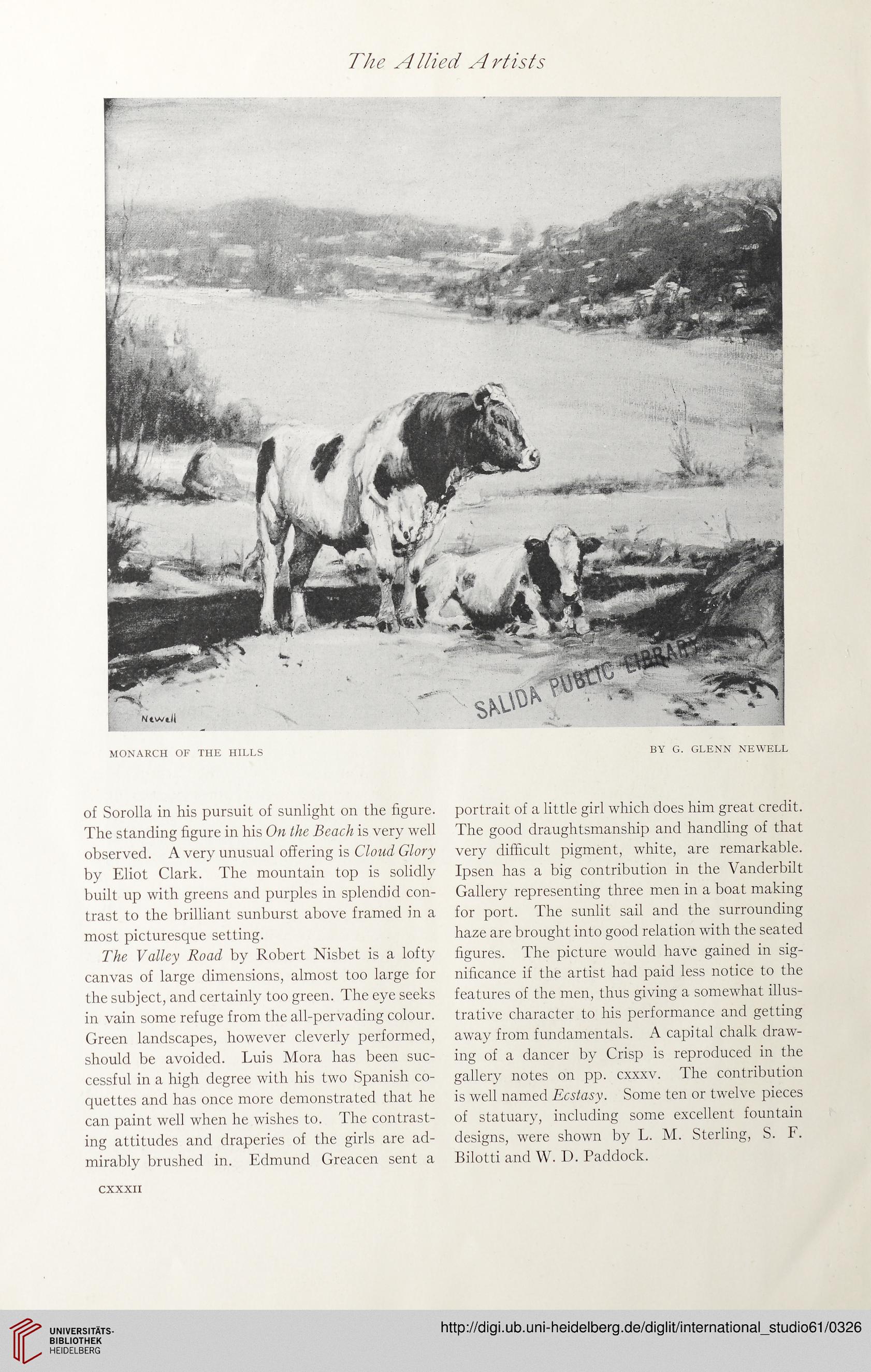The Allied Artists
F
MONARCH OF THE HILLS BY G. GLENN NEWELL
of Sorolla in his pursuit of sunlight on the figure.
The standing figure in his On the Beach is very well
observed. A very unusual offering is Cloud Glory
by Eliot Clark. The mountain top is solidly
built up with greens and purples in splendid con-
trast to the brilliant sunburst above framed in a
most picturesque setting.
The Valley Road by Robert Nisbet is a lofty
canvas of large dimensions, almost too large for
the subject, and certainly too green. The eye seeks
in vain some refuge from the all-pervading colour.
Green landscapes, however cleverly performed,
should be avoided. Luis Mora has been suc-
cessful in a high degree with his two Spanish co-
quettes and has once more demonstrated that he
can paint well when he wishes to. The contrast-
ing attitudes and draperies of the girls are ad-
mirably brushed in. Edmund Greacen sent a
portrait of a little girl which does him great credit.
The good draughtsmanship and handling of that
very difficult pigment, white, are remarkable.
Ipsen has a big contribution in the Vanderbilt
Gallery representing three men in a boat making
for port. The sunlit sail and the surrounding
haze are brought into good relation with the seated
figures. The picture would have gained in sig-
nificance if the artist had paid less notice to the
features of the men, thus giving a somewhat illus-
trative character to his performance and getting
away from fundamentals. A capital chalk draw-
ing of a dancer by Crisp is reproduced in the
gallery notes on pp. cxxxv. The contribution
is well named Ecstasy. Some ten or twelve pieces
of statuary, including some excellent fountain
designs, were shown by L. M. Sterling, S. F.
Bilotti and W. D. Paddock.
cxxxn
F
MONARCH OF THE HILLS BY G. GLENN NEWELL
of Sorolla in his pursuit of sunlight on the figure.
The standing figure in his On the Beach is very well
observed. A very unusual offering is Cloud Glory
by Eliot Clark. The mountain top is solidly
built up with greens and purples in splendid con-
trast to the brilliant sunburst above framed in a
most picturesque setting.
The Valley Road by Robert Nisbet is a lofty
canvas of large dimensions, almost too large for
the subject, and certainly too green. The eye seeks
in vain some refuge from the all-pervading colour.
Green landscapes, however cleverly performed,
should be avoided. Luis Mora has been suc-
cessful in a high degree with his two Spanish co-
quettes and has once more demonstrated that he
can paint well when he wishes to. The contrast-
ing attitudes and draperies of the girls are ad-
mirably brushed in. Edmund Greacen sent a
portrait of a little girl which does him great credit.
The good draughtsmanship and handling of that
very difficult pigment, white, are remarkable.
Ipsen has a big contribution in the Vanderbilt
Gallery representing three men in a boat making
for port. The sunlit sail and the surrounding
haze are brought into good relation with the seated
figures. The picture would have gained in sig-
nificance if the artist had paid less notice to the
features of the men, thus giving a somewhat illus-
trative character to his performance and getting
away from fundamentals. A capital chalk draw-
ing of a dancer by Crisp is reproduced in the
gallery notes on pp. cxxxv. The contribution
is well named Ecstasy. Some ten or twelve pieces
of statuary, including some excellent fountain
designs, were shown by L. M. Sterling, S. F.
Bilotti and W. D. Paddock.
cxxxn




